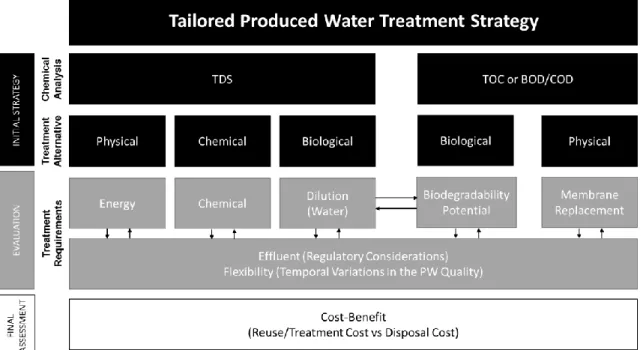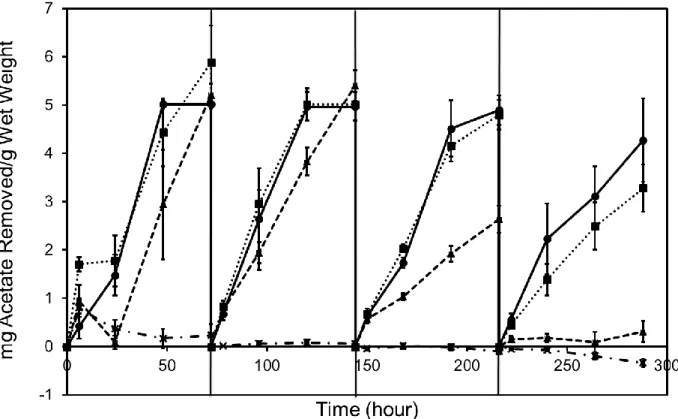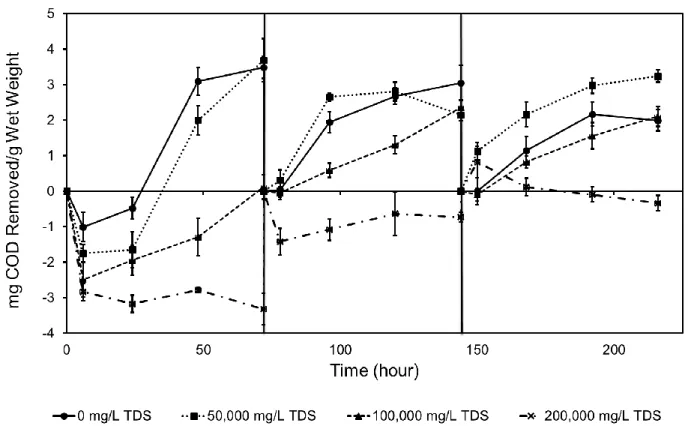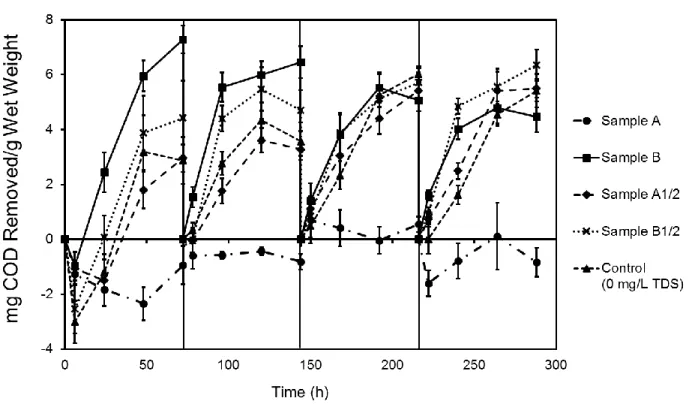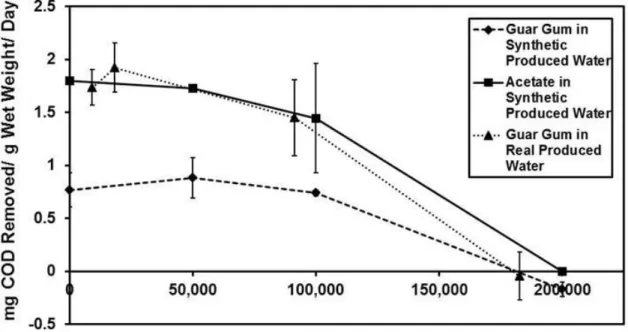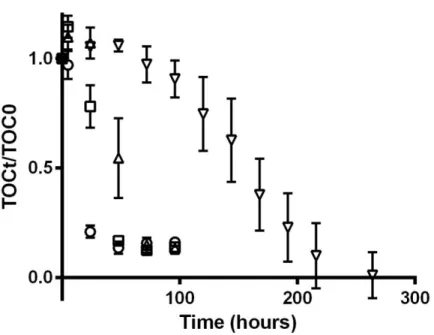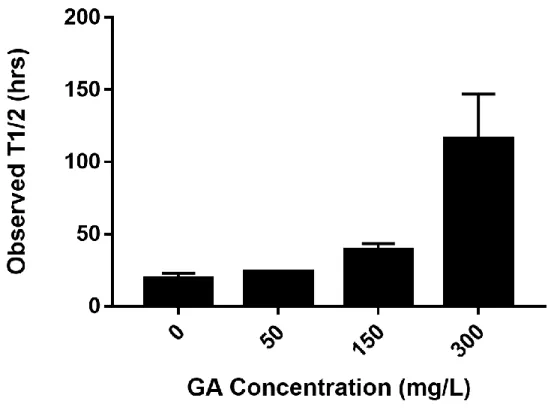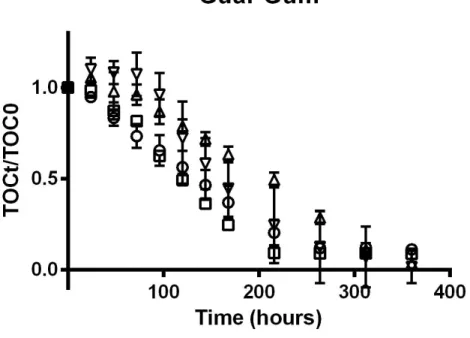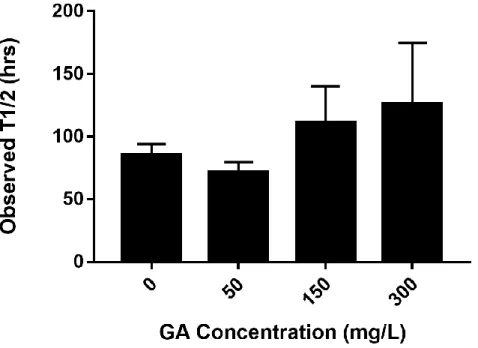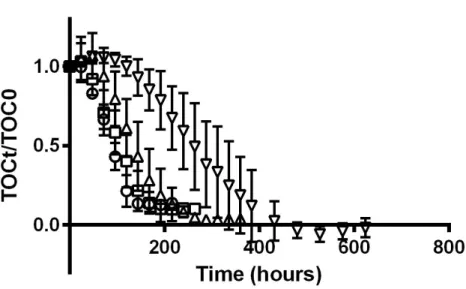BIOLOGICAL TREATMENT OF HYDRAULIC FRACTURING PRODUCED WATER
by Benay Akyon
Bachelor of Engineering in Environmental Engineering, Middle East Technical University, 2012
Submitted to the Graduate Faculty of
Swanson School of Engineering in partial fulfillment of the requirements for the degree of
Doctor of Philosophy
University of Pittsburgh 2017
ii
UNIVERSITY OF PITTSBURGH SWANSON SCHOOL OF ENGINEERING
This dissertation was presented
by
Benay Akyon
It was defended on March 23, 2017 and approved by
Kyle J. Bibby, Ph.D., Assistant Professor, Civil and Environmental Engineering Department Radisav D. Vidic, Ph.D., Professor, Civil and Environmental Engineering Department Vikas Khanna, Ph.D., Assistant Professor, Civil and Environmental Engineering Department
John Stolz, Ph.D., Professor, Department of Biological Sciences (Duquesne University) Dissertation Director: Kyle J. Bibby, Ph.D., Assistant Professor, Civil and Environmental
iii
Copyright © by Benay Akyon 2017
iv
Hydraulic fracturing enables the enhanced recovery of hydrocarbons from shale formations while generating large volumes of produced water, i.e. wastewater from hydraulic fracturing. Treatment of produced water for reuse or final disposal is challenged by both high salinity and the presence of organic compounds. This dissertation is focused on the biological treatment of produced water using a mixed-culture biofilm approach to remove the available electron donors and therefore, potentially limit microbial growth, biocide use, and fouling of wells (during reuse) and membranes (during treatment prior to final disposal). Conventional activated sludge treatments are intolerant of high salinity, thus a biofilm approach was proposed to provide a more robust treatment method for high salinity produced waters. First, a preliminary evaluation on COD biodegradation (as acetate and guar gum) in synthetic and real produced waters was performed. Biodegradation was mainly driven by salinity; however, microbial activity was observed at salt concentrations as high as 100,000 mg/L TDS. Next, the effect of glutaraldehyde (GA), a commonly used biocide in hydraulic fracturing, on biodegradation of organic chemicals that are commonly used in fracturing fluids, is investigated. Results demonstrated that glutaraldehyde can affect the observed lag period and half-lives of the compounds, depending on the compound. Finally, the biodegradation of produced waters were evaluated in seven samples from different wells. Results showed a negative correlation between salinity and biodegradation rates. Moreover, variable biodegradation rates were observed at the same salt concentration.
BIOLOGICAL TREATMENT OF HYDRAULIC FRACTURING PRODUCED WATER
Benay Akyon, Ph.D. University of Pittsburgh, 2017
v
Finally, a Ra-226 biosorption was evaluated in synthetic and real produced waters to determine the efficacy of Ra-226 removal by a halophilic microalga D. salina.
This study contributes to the understanding of biological treatment applicability in produced water management. The proposed biofilm approach could further encourage the use of similar approaches in produced water treatment and possibly in other industrial wastewaters containing high salinity and toxic chemicals. The evaluation of the biocide effect on biodegradation can enhance the understanding and accuracy of environmental model predictions for bio-treatment, bio-remediation, and pollution transport. Ultimately, this dissertation will contribute to more sustainable and economical produced water management strategies.
vi
TABLE OF CONTENTS
1.0INTRODUCTION ………..1
1.1PROBLEM IDENTIFICATION………2
1.2RESEARCH OBJECTIVES ……….3
2.0A REVIEW OF BIOLOGICAL TREATMENT FOR PRODUCED WATER FROM…. HYDRAULIC FRACTURING: CHALLENGES AND OPPORTUNITIES……….6
2.1INTRODUCTION……….6
2.2CHALLENGES IN PRODUCED WATER MANAGEMENT AND BIOLOGICAL... TREATMENT……….8
2.2.1 Salinity…..………...9
2.2.2 Radionuclides……..………...11
2.2.3 Biocides….……….13
2.2.4 Toxicity….……….15
2.2.5 Variation in organic content and concentration……….17
2.3 OPPORTUNITIES FOR BIOLOGICAL PRODUCED WATER TREATMENT….18 2.3.1 Biodegradable compounds…………..………..19
2.3.2 Saline tolerant bio-treatment approaches………..20
2.4 DECISION-MAKING IN PRODUCED WATER TREATMENT……….24
vii
3.0 BIOFILMS AS A BIOLOGICAL TREATMENT APPROACH FOR PRODUCED……
WATER FROM HYDRAULIC FRACTURING………...…..28
3.1 INTRODUCTION………...29
3.2 MATERIALS AND METHODS……….31
3.2.1 Construction of engineered biofilms………..………...31
3.2.2 Preparation of test media…………..………32
3.2.3 Experimental procedure………….………...34
3.2.4 Rate analysis and kinetics…………...………...35
3.3 RESULTS AND DISCUSSION………..35
3.4 SUMMARY AND CONCLUSION………42
4.0 EFFECT OF GLUTARALDEHYDE (GA) ON BIOFILM TREATMENT PERFORMANCE IN HYDRAULIC FRACTURING PRODUCED WATER…….44
4.1 INTRODUCTION………...45
4.2 MATERIALS AND METHODS……….46
4.2.1 Biofilm preparation………..……….46
4.2.2 Preparation of the test media……….……….…...47
4.2.3 Experimental procedure…………..………..48
4.2.4 Total dissolved organic carbon (TOC) analysis……….…...49
4.2.5 Data analysis and rate kinetics………...………...49
4.3 RESULTS AND DISCUSSION………..51
4.3.1 Biodegradation results…………..………51
4.3.2 Plate colony counts……….……….…….64
4.4 SUMMARY AND CONCLUSION..………..68
5.0 REMOVAL OF ORGANICS FROM HYDRAULIC FRACTURING PRODUCED ….. WATER USING AN ENGINEERED BIOFILM APPROACH………..……...69
viii
5.1 INTRODUCTION………...70
5.2 MATERIALS AND METHODS……….71
5.2.1 Sample collection and analysis………...………...71
5.2.2 Biofilm preparation………..……….72
5.2.3 Experimental procedure…………..………..72
5.2.4 Total dissolved organic carbon (TOC) analysis………..….…….73
5.2.5 Data analysis and rate kinetics……….……….……74
5.3 RESULTS AND DISCUSSION………..75
5.4 SUMMARY AND CONCLUSION………....80
6.0 RADIUM-226 BIOSORPTION BY THE HALOPHILIC MICROALGAE……… DUNALIELLA SALINA IN PRODUCED WATER FROM THE……….. MARCELLUS SHALE ………..82
6.1 INTRODUCTION………...82
6.2 MATERIALS AND METHODS……….85
6.2.1 Culture growth and biomass preparation………..…………..…..85
6.2.2 D. salina growth in produced water………..……….…..……….85
6.2.3 Biosorption in synthetic media…………...………..87
6.2.4 Biosorption in produced water……….………...………..88
6.2.5 Data analysis……..………...89
6.3 RESULTS AND DISCUSSION………..90
6.4 SUMMARY AND CONCLUSION………...………...104
7.0 IMPLICATIONS AND CONCLUSION………...………105
APPENDIX A………...………..107
APPENDIX B………...………..108
ix
LIST OF TABLES
2.1 Chemical produced water characteristics of various shale plays ………..…..18
2.2 Biological treatment technologies proposed for produced waters from hydraulic fracturing.23 3.1 Chemical characteristics of synthetic produced water, Sample A, and Sample B………..…33
4.1 The five most frequently-reported1 biodegradable organic chemicals evaluated………51
4.2 First order rate constants and half-lives for compounds at changing glutaraldehyde………….. concentration……….54
4.3 P-values from two-sample t-test for the observed half-lives at different glutaraldehyde……… concentrations………..……….55
4.4 Two-sample t-test p-values for colony counts at changing glutaraldehyde concentration….66 5.1 Chemical characteristics of produced water samples………..……75
5.2 First order degradation kinetics for produced water samples………..………78
6.1 Chemical characteristics of produced water samples S1 and S2 ………..…………..86
6.2 Produced water composition for Ra-226 biosorption experiments…………...………...89
x
LIST OF FIGURES
2.1 Decision-making scheme for tailored produced water treatment strategy………...25
3.1 Acetate removed in synthetic produced water as a function of time………...…37
3.2 Guar gum removed in synthetic produced water as a function of time………...38
3.3 Guar gum removed in real produced water as a function of time………39
3.4 Microbial mat substrate removal rates in synthetic and real produced water………..41
4.1 Acetate removal at 0, 50, 150, and 300 mg/L glutaraldehyde concentrations……….52
4.2 Observed half-lives for acetate at 0, 50, 150, and 300 mg/L glutaraldehyde concentrations..53
4.3 Guar gum removal at 0, 50, 150, and 300 mg/L glutaraldehyde concentrations…………....56
4.4 Observed half-lives for guar gum at 0, 50, 150, and 300 mg/L glutaraldehyde……….. concentrations………..………..…57
4.5 Ethylene glycol removal at 0, 50, 150, and 300 mg/L glutaraldehyde concentrations………58
4.6 Observed half-lives for ethylene glycol at 0, 50, 150, and 300 mg/L glutaraldehyde………… concentrations………59
4.7 Ethanol removal at 0, 50, 150, and 300 mg/L glutaraldehyde concentrations………...60
4.8 Observed half-lives for ethanol at 0, 50, 150, and 300 mg/L glutaraldehyde………. concentrations………..…………..61
4.9 Isopropanol removal at 0, 50, 150, and 300 mg/L glutaraldehyde concentrations…………..63
4.10 Observed half-lives for isopropanol at 0, 50, 150, and 300 mg/L glutaraldehyde……… concentrations………64
xi
4.11 Colony counts per mL of sample per gram of biofilm weight at the beginning and end of….
the experiments at GA concentrations ranging from 0-300 mg/L………..……...65
5.1 Removal of TOC as a function of time at 50,000 mg/L TDS produced waters………...…...76
5.2 Removal of TOC as a function of time at 100,000 mg/L TDS produced waters…………....79
6.1 D. salina growth in 2X Erdschreiber’s medium and a one-half dilution of produced water….. sample S2………..……….92
6.2 Cell counts as a function of optical density at 680 nm ………...………93
6.3 Specific growth rate of control and S2(1:2 dilution)…………...………94
6.4 Remaining Ra-226activity (Cs) as a function of pH at equilibrium……….………..95
6.5 Remaining Ra-226activity (Cs) as a function of TDS at equilibrium ………97
6.6 Remaining Ra-226 activity and % Ra-226 removal at equilibrium as a function of………….. autoclaved D. salina biomass concentration……….………....99
6.7 Equilibrium isotherms for Ra-226 biosorption with autoclaved D. salina biomass………..100
6.8 Initial and final Ra-226 activity and Ra-226 removal (%) as a function of TDS in produced… water samples………...102
xii PREFACE
My special thanks to my mother Ayse, my father Bekir Sitki, and my grandmother Nazife. They raised me bravely.
1
1.0 INTRODUCTION
This dissertation investigates the challenges and opportunities of produced water management with a special focus on biological treatment of produced water using a mixed-culture biofilm approach. Additionally, radium-226 (Ra-226) biosorption in produced waters using halotolerant microalgae Dunaliella salina was investigated.
Advances in high-volume hydraulic fracturing and horizontal drilling techniques require the injection of 10-20 million liters (2-5 million gallons) of fluids at high pressure to fracture the target formation and thus stimulate reservoir permeability.2-4 Fracture fluid, that is typically composed 98-99% water and sand, 1-2% fracturing chemicals,2, 5, 6 mixes with the subsurface brine and returns to the surface as produced water.5, 6 Produced water typically has an elevated total dissolved solids (TDS) concentration that ranges from 5,000 to 300,000 mg/L,7-9 including high concentrations of sodium, calcium, barium, strontium, chloride, bromide, and naturally occurring radioactive material (NORM). Among the NORM, radium is the most common due to its soluble nature in a large spectrum of pH conditions.9-11 Moreover, the organic content of produced water can vary greatly by wellsite depending on the additives in the fracturing fluid. Previous results show that organic concentration in produced waters from shale plays can range between 1.2 – 5,804 mg/L TOC.12, 13 Thus, both fracture fluid and produced water characteristics are unique to each geological formation.10 In the following sections, the problems associated with produced water management and the research objectives of this dissertation will be stated.
2
1.1 PROBLEM IDENTIFICATION
Water management challenges associated with hydraulic fracturing, including produced water disposal and water sourcing for fracturing, have emerged at the forefront of the public and regulatory discussion regarding hydraulic fracturing. Due to large volumes, high salt and radionuclide concentrations, and organic content, disposal and treatment options for produced water are limited. Currently, disposal via deep well injection is among the most frequently used produced water management strategies and will likely continue to be in the future, since concentrated brine produced after desalination processes can be disposed in regulated underground wells.14 EPA regulates the injection of fluids associated with oil and gas production (e.g., class II wells) under the Underground Injection Control program and necessary permits need to be obtained from the authorities.15 However, this method has been linked to induced seismicity16 and, hence, high volumes of produced water injection is not likely to be sustainable in the long run. For instance, wastewater disposal volumes in central Oklahoma nearly doubled from 2004 to 2008 and seismicity in that area was reported to increase 40-fold during 2008-2013 compared to the period from 1976 to 2007. This amount is comprising 45% of the seismicity with magnitude (M)3 or larger in the central and eastern U.S between 2008 and 2013.16 Moreover, treatment of produced water in municipal wastewater treatment plants for surface disposal is no longer a viable alternative with new regulations in effect.2 Finally, in some regions with suitable disposal capacity, there are concerns about the environmental impacts of fresh water sourcing.17, 18 Therefore, an on-site, low cost, low maintenance produced water treatment approach can prove to be both environmentally and economically beneficial for either reuse or final disposal.
3
Biological treatment is a promising and underexplored treatment technology to remove organic compounds in high-salinity produced water. Biological treatment approaches may be used in conjunction with physical-chemical treatment to limit energy costs and membrane fouling for both produced water reuse in future hydraulic fracturing operations and final disposal. Additionally, reduced concentrations of organic compounds due to biological treatment would limit heterotrophic microbial growth during produced water holding, and thus decrease the need for biocide use. Furthermore, there is evidence that biocides in produced water can alter the contamination transport durations and distances.19 Additionally, biosorption could prove useful for the removal of inorganic produced water constituents that cannot be degraded biologically and further help to decrease NORM concentration, potential odor production, toxicity, and corrosion by sulfates.
1.2 RESEARCH OBJECTIVES
This dissertation investigates the biological treatment of produced water using a mixed-culture biofilm approach, evaluating co-contaminant interactions of organics in the presence of a biocide. Additionally, radium-226 (Ra-226) biosorption using the halotolerant microalgae Dunaliella salina was evaluated.
The first research objective was to develop and use a mixed-culture engineered biofilm approach to treat synthetic and real produced waters from hydraulic fracturing with an external COD source. Biological treatment to remove available electron donors has the potential to decrease heterotrophic microbial growth and the necessity for biocide use. The development of on-site biological removal processes will encourage produced water reuse in future hydraulic
4
fracturing operations, reducing the environmental impacts of fresh water sourcing, the costs related to produced water transportation and disposal, and excess biocide use.
The second research objective was to evaluate the effect of glutaraldehyde (a commonly used biocide) on biodegradation of organics used in hydraulic fracturing. Evidence has shown that the presence of toxic compounds such as biocides can alter the biodegradation potential of organics in produced water19, creating concerns in case of an environmental exposure.20
The third research objective was to use the mixed-culture biofilms to treat produced waters with no external organic addition. This approach can potentially create a more applicable knowledge for this treatment method to be implemented in real-world scenarios.
The final research objective was to evaluate the removal Ra-226 from produced waters via biosorption. Limited earlier studies21, 22 showed that Ra-226 biosorption could be promising to be used in produced water to help removing Ra-226 using a low-cost treatment approach.
This dissertation is composed of seven chapters in which five journal manuscripts are presented. Chapter 1 consists of an introduction, problem identification, and the research objectives. The main goal of Chapter 2 is to review the current challenges and opportunities associated with produced water management and the current biological treatment approaches applied to produced waters. An additional goal is to propose a decision-making approach for real world applications of produced water treatment. In Chapter 3, the research objective is to evaluate the chemical oxygen demand (COD) removal in synthetic and real produced water using engineered biofilms at various salinity concentrations (0 – 200,000 mg/L TDS). The research objective in Chapter 4 is to evaluate the effect of glutaraldehyde (a frequently used biocide in hydraulic fracturing) concentration (0 – 300 mg/L) on the readily biodegradable organic compounds commonly reported in produced waters at 50,000 mg/L TDS. The research
5
objective in Chapter 5 is to investigate the biodegradation of organics in produced water samples from unconventional shale plays using the biofilm approach developed in Chapter 3 and 4. In Chapter 6, I used D. salina to evaluate Ra-226 biosorption at changing salt, pH, and biomass concentrations and finally biosorption in Marcellus Shale Produced Water. Finally, in Chapter 7 an overall summary and conclusions of the findings reported in this dissertation and suggestions future research goals and possible environmental implications for real-world scenarios were provided.
6
2.0 A REVIEW OF BIOLOGICAL TREATMENT FOR PRODUCED WATER FROM HYDRAULIC FRACTURING: CHALLENGES AND OPPORTUNITIES
2.1 INTRODUCTION
Energy production in the United States is highly dependent on natural gas, coal, and oil (85% of the nation’s supply). High-volume hydraulic fracturing combined with horizontal drilling, known colloquially as ‘fracking’ has become an important part of the United State’s (and World’s) energy mix. Horizontal drilling was first used in Barnett Shale and created great interest for enhancing oil and gas production.23 Further improvements in horizontal drilling and hydraulic fracturing led to the expansion of unconventional natural gas and oil generation. Shale oil production in U.S. started to increase exponentially in 2004, and has increased linearly since 2012.24 Eagle Ford and Bakken Shales are among the most productive shale oil plays. Shale oil production has a great impact in the overall oil production in the U.S. In 2014, shale oil (3.6. million barrels/day – mbd) comprised half of the total crude oil production (8.2 mbd), and met one quarter of the total oil demand (15.5 mbd – a total of produced and imported crude oil) in the U.S.24 Total crude oil production in the U.S. continues to increase and forecasted to reach 9.7 mbd in 2018.25 The high energy content of natural gas (about 30 kj/m3), decreased CO2 emissions, and criteria pollutants make it a desirable energy source.8, 26 The gas reserves of the major shale formations in the U.S. (e.g., Barnett, Haynesville/Bossier, Antrim, Fayetteville, New Albany, and Marcellus) have been estimated to be able to supply the country for at least 90
7
years.8 The Marcellus Shale, one of the top five unconventional gas reservoir in the U.S., is a black, organic rich shale in the Northern Appalachian basin with an estimated production capacity of 489 trillion cubic feet natural gas.8, 26, 27
Hydraulic fracturing is the process of injecting high volumes of fracturing fluid into shale formations under high pressure (480 – 680 bar) to increase permeability to recover gas and oil trapped in the formation.10 The composition of the fracturing fluid varies depending on the shale formation and the preferences of the industry. Fracturing fluid generally includes 98-99% water and sand, and 1-2% chemical additives such as gelling agents, friction reducers, scale inhibitors, biocides, and gel breakers.6, 28 The amount of water used to open a new well can range between 2 to 8 million gallons depending on the well length and is generally supplied locally, either using available surface water or groundwater.23 Water usage raises concerns and requires effective local management especially in locations with a limited water supply.8, 23 After fracturing a well, a fraction of the water injected (varies depending on the wellsite) returns over a period of 30 days and this water is called flowback water.5 Once the well is in production, the returning water is then referred to as produced water.6, 29
Produced water management strategies vary according to regional regulations. Some common disposal methods include deep well injection, reuse, open pits for evaporation, and processing in wastewater treatment plants. In the United States, the U.S. EPA regulates the injection of fluids associated with oil and gas production (i.e., class II wells) under the Underground Injection Control program and necessary permits need to be obtained from the authorities.15 However, disposal wells have been linked to induced seismicity16 challenging the sustainability of this approach. For instance, wastewater disposal volumes in central Oklahoma had nearly doubled from 2004 to 2008 and seismicity in that area was reported to increase
40-8
fold during 2008-2013 compared to the period from 1976 to 2007. Disposal well injection has been linked to 45% of the seismicity with magnitude (M)3 or larger in the central and eastern U.S between 2008 and 2013.16
Alternative approaches for produced water management include reuse (internal – to open new wells – or external – for livestock watering and irrigation) or treatment for disposal to surface water. Reuse of produced water to fracture new wells has become a common practice in Pennsylvania. Reports from 831 wells in Pennsylvania show that 10% of the water used for the fracturing of a new well comes from flowback water and the rest consists of fresh water coming either from surface waters or purchased from public supplies.29 In the following sections, the challenges and opportunities associated with produced water management and biological treatment were discussed, and a decision-making approach for determination of appropriate treatment technology for individual wells was proposed.
2.2 CHALLENGES IN PRODUCED WATER MANAGEMENT AND BIOLOGICAL
TREATMENT
Extraction of hydrocarbons from shale formations results in large volumes of produced waters that require treatment and disposal; however, development of treatment approaches has lagged behind compared to the development of hydrocarbon extraction methodologies. Current methods for produced water management primarily include deep well injection, reuse, and treatment. In the Marcellus Shale, approximately 60% of the produced water is treated and reused, and the rest is disposed of via deep-well injection.30 Reusing produced water requires removal of scale-forming constituents such as Ba, Ca, Fe, Mg, Mn, and Sr to minimize scaling and fouling.8
9
Moreover, biocides are used to inhibit microbial growth in wells and in holding ponds as microorganisms can cause fouling and souring. Disposal of produced waters to surface water requires treatment to reduce salinity (TDS < 500 mg/L in Pennsylvania) and municipal wastewater treatment plants are not permitted to accept produced waters in some states (such as Pennsylvania).2 The unique composition of produced water can affect physical, chemical, and biological treatment methods. For instance, high salinity in produced waters increases the energy requirements, and the organic and microbiological content increase fouling potential of membranes—leading to increased cost and maintenance issues.
Biological treatment methods have been widely employed in other wastewaters to remove dissolved organic contaminants. Thus, biological treatment alternatives can increase physical-chemical process performance of produced water treatment by removing fouling organics and organic constituents poorly removed by these processes. Nevertheless, there are certain challenges that need to be addressed for the effective use of biological treatment of produced waters. The basic challenges for both final disposal and biological treatment are salinity, the presence of biocides, and varying organic carbon content and concentration. In addition, final disposal is also challenged by high radionuclide content and toxic compounds present in the produced water. In this section, the produced water management challenges were discussed in detail, from the perspective of both final disposal and biological treatment.
2.2.1 Salinity
Following the hydraulic fracturing of a well, produced water begins to return mixed with gas, oil, and, potentially, formation water from the shale. This flow continues as a decreased volume until the hydrocarbon production of the well ends. The concentration of total dissolved solids (TDS)
10
in produced water increases as time passes following the fracturing.10 TDS concentration in produced water can range from 5,000 to greater than 300,000 mg/L.7-9 The most common inorganic constituents in Marcellus Shale produced waters are Na, Ca, Cl, Ba, Ra, Sr, Mg, Br, Fe, and Mn.10, 31 The source of salinity in produced water is largely believed to be from concentrated seawater. Barbot et al. investigated 160 flowback and produced water samples from the Marcellus Shale.10 Their results showed that produced water from conventional wells and high salinity produced water samples (from late in the production period) exhibit trends similar to those of concentrated seawater. However, there were no clear similarities between seawater evaporation and less concentrated produced water samples from early in the production period.10 According to Haluszczak et al., the Br/Cl ratio of produced waters indicates that mixing with the formation waters has an important role in the high salinity of produced waters and that dissolution of salt and minerals from the rock units is not the main mechanism for high salt concentration in produced waters.31
Recent regulations in Pennsylvania (2010) require effluent concentrations of 500 ppm (mg/L), 250 ppm, 10 ppm for TDS, Cl, Ba, and Sr (based on monthly averages), respectively, for the facilities treating natural gas wastewaters for surface disposal.29 Hence, the removal of salts is a prerequisite for surface discharge of produced waters. Municipal wastewater treatment facilities do not remove high TDS concentrations that decrease the efficiency of biological treatment units, and produced water dilution with municipal wastewater is not sufficient in some places due to the high volumes (in Pennsylvania regulations do not allow gas drilling operators to send produced water to publicly owned treatment plants).29 Therefore, produced waters either must be sent to brine treatment facilities or be disposed of by deep well injection. The
11
concentrated brine produced after the desalination processes can be disposed in regulated disposal wells.14
The influence of salinity on biological treatment has been studied previously.32, 33 Recent studies showed that salt concentration in produced water is the main factor affecting the rate of biodegradation34, 35 and, therefore, salinity is one of the primary challenges that must be considered in biological treatment strategies. It has been previously shown that activated sludge treatment systems (suspended growth) have limited tolerance to salinity concentrations above 10,000 mg/L.32, 33 Thus, more robust biological treatment methods, such as attached growth systems (e.g., biofilms) or produced water dilution, may be considered if applicable.
2.2.2 Radionuclides
Elevated concentrations of Naturally Occurring Radioactive Material (NORM) originate from the subsurface formations.31 Geochemical properties of the shale formation can affect the dissolution of NORM. For instance, high ionic strength and low SO42- concentrations can increase radium-226 solubility.36 Among NORM, the alkaline earth metal radium-226 (Ra-226) is especially concerning due to its high concentration in produced water, radioactive properties, and half-life of 1,620 years. Ionizing radiation caused by the decay of radioactive materials during long-term exposure can increase the risk of cancer.37 Moreover, Nelson et al. (2015) estimated that in a closed system where Ra-226 decays, the radioactivity level increases by a factor of 8 in 100 years.36 The industrial discharge limit for radium in the U.S. is 60 pCi/L9 and the maximum contaminant level (MCL) in the National Primary Drinking Water Regulations for combined concentration of Ra-226 and Ra-228 is 5 pCi/L.38 On the other hand, the radium concentrations reported in produced waters can be alarmingly high, reaching total radium
12
activities up to 10,000 pCi/L in produced waters from the Marcellus Shale.39 Median radium activities reported in Marcellus and non-Marcellus reservoirs (including Medina, Theresa, Queenstone, Rochester, Bass Islands, Onondaga, Oriskany, Helderberg, and more) are 2,460 pCi/L and 734 pCi/L, respectively.39 Previously, 13 produced water samples were analyzed by New York’s Department of Environmental Conservation and elevated Ra-226 concentrations were found (up to 267 times the limit for safe discharge).40
There are two main issues related to Ra-226 management in produced waters. One of the challenges is its detection. The most commonly used approaches for radium detection are often time and labor intensive, such as alpha spectrometry (which takes 3 weeks of radon-222 equilibrium period)41, liquid scintillation (which involves tedious sample preparation procedures), and gamma spectrometry (with 24-48 hours counting times).39, 42 Moreover, the recovery of Ra-226 can be challenged by high TDS concentration due to ionic interferences43 and the current wet chemical purification techniques performed prior to measurement suffers from high concentration of divalent cations such as Ba, Ca, and Sr.42 However, a recent study proposed a rapid Ra-226 analysis using ICP-MS and their results showed accurate detection of Ra-226 even at 415,000 mg/L TDS concentration and an average of 97% recovery by ICP-MS.42
The second issue related to Ra-226 in produced water is that Ra-226 concentration tends to increase during reuse of produced water and as the sediments in holding ponds age, starting from less than 10 pCi/g in fresh sediments to several hundred pCi/g in aged sediments.44 The Ra-226 accumulation in the sediments occurs due to co-precipitation with BaSO4, hence, aged sludge could require to be handled as radioactive solid waste since it could exceed the disposal limits of municipal landfills.44
13
A potential treatment to remove radium from produced water is biosorption. Biosorption of Ra-226 has been studied in the literature21, 22, 45 and in Chapter 6. Tsezos et al. used biomass (return sludge from a municipal wastewater treatment plant) as a biosorption medium to remove Ra-226 in aqueous solutions and in wastewaters from uranium mining operations. Their results showed that acidic pH (pH = 2) limited the Ra-226 adsoption.21 Satvanamesh et al. used bacterial strains isolated from hot springs and soil from areas of elevated radiation in Ramsar, Iran to evaluate Ra-226 biosorption in aqueous solutions. They reported a wide variation in the Ra-226 biosorption from 53 Bq.g-1 to 202 Bq.g-1 depending on the bacterial strain used.45 One of the greatest challenges for removing Ra-226 from produced waters using biomass is the high salinity concentration. Rowan et al. reported that Ra-226 activity is correlated with the salt concentration in produced waters39 and studies (in the literature46, 47 and in Chapter 6) showed decreased ion uptake with increasing ionic strength. In Chapter 6, Ra-226 removal in synthetic produced water using a halophilic alga at changing salinity concentrations (0 – 200,000 mg/L NaCl) was evaluated. Our results demonstrated a positive correlation between the remaining Ra-226 activity at equilibrium and salt concentration. It was suggested previously that divalent alkaline earth metal ions (e.g., Ca, Sr, Ba, Ra) can form surface complexes that bond weakly with the hydroxide surfaces, and that increased ionic strength can lead to the competition of ions for the available active surfaces.47, 48
2.2.3 Biocides
A wide variety of biocides are used in hydraulic fracturing operations to limit the growth of bacteria (i.e. sulfate reducing bacteria, acid producing bacteria) that can cause clogging, corrosion, and souring of the wells.49 Among those glutaraldehyde (GA),
dibromo-14
nitrilopropionamide, tetrakis hydroxymethyl, dodecyl dimethyl ammonium chloride, and chlorine dioxide are the biocides that are most commonly used.50
Biocides are used aboveground, for produced water storage, and in pipelines. They are also often used in the fracturing process and for well maintenance.50 The selection criteria of biocides include the properties of the geological formation, the compatibility with other chemicals and the environment, the cost, and the desired bacterial control.50, 51 However, current practices on selecting biocides can also depend on historical usage and may not be specialized for individual wells.50
The use of biocides may affect biological treatment systems and result in biomass loss. Biocides can also transform into more toxic compounds and react with other chemicals during use, possibly altering the biodegradation rates of the compounds present in produced waters during biological treatment or in case of an accidental release.19 For instance, a recent study showed that biodegradation of polyethylene glycol surfactants used in hydraulic fracturing can be limited by the presence of biocides (i.e., glutaraldehyde was used as the model biocide in their experiments).19 Moreover, there is evidence that increased salt concentration tends to decrease GA transformation,52 demonstrating that biocide degradation can be further impeded by the high salt concentration in produced waters, increasing the longevity of its toxic effects. Current research suggests that contaminant interaction effects need to be evaluated to determine the environmental persistence of hydraulic fracturing chemicals and biocides. In Chapter 4, the effect of GA on biodegradation of the most commonly reported fracturing fluid chemicals using a biofilm approach was evaluated. The results demonstrated varying observed lag periods and half-lives at changing GA concentrations, depending on the compound and suggest that
co-15
contaminant interactions should be taken into consideration for the determination of the environmental toxicity of mixtures.
2.2.4 Toxicity
A desirable outcome of biological produced water treatment would be removal of toxic compounds for subsequent reuse or disposal. The chemicals present in the produced waters are a combination of introduced chemicals during fracturing and formation chemicals. Toxic metals, salts, and radionuclides can be released from the formations and mixed in the fracturing fluid that flows back to the surface. Chemicals used in fracturing fluids have certain functions in the fracturing process such as regulation of viscosity, pH, microbial growth inhibition, friction reduction, and scale inhibition. Among the ingredients reported in fracturing fluids, there are compounds with high acute toxicity (Globally Harmonized System of Classification and Labeling of Chemicals – GHS – defines acute toxicity categories from 1-4, 1 being the highest - https://www.osha.gov/dsg/hazcom/appendix_a.pdf) such as glutaraldehyde (GHS Category 1), thiourea, and 2-butoxyethanol (GHS Category 2).20 Based on rat inhalation and oral toxicity data, of 81 components, Stringfellow et al. identified 13 (16%) hydraulic fracturing chemicals to have low to moderate toxicity, and 25 (31%) chemicals lacking toxicity information. The remaining 43 (53%) chemicals were considered as non-toxic.20 A previous study predicted 19 compounds in fracturing fluids to have “elevated exposure potential” via groundwater, meaning these compounds were identified in more than 50 FracFocus reports and were predicted to have more than 10% of their concentration remaining at 94m setback distance.1 It is important to note that this study did not account for downhole transformation products, mixture toxicity, and potential
16
co-contaminant interactions that may result in different biodegradation, mobility, and solubility values.1
Evaluation of the toxicity caused by unconventional oil and gas production is challenging due to incomplete disclosure of the compound identity and the concentrations used in fracturing chemicals, the wide spectrum of chemical structures (e.g., organic, inorganic, radioactive), the variation in the compound use depending on the geographical properties of the shale formation, physicochemical properties of fracturing chemicals (e.g., octanol-water partition), temporal variations in emissions and exposure, and, finally, a lack of measurements of health-relevant compounds.53 Although the chemicals introduced into fracturing fluids only account for 1-2% of the total volume, this amount could reach from 150,000 to 600,000 liters of chemicals to open a new well.53, 54 A recent study performed detailed toxicity evaluations for hydraulic fracturing chemicals53 and, according to their investigations, 781 (76%) out of 1021 identified hydraulic fracturing chemicals did not have reproductive and developmental toxicity information in the investigated toxicity data bases (e.g., REPROTOX). Of the 240 chemicals with available toxicity data, 126 chemicals had reproductive and 192 had developmental toxicity information available. A total of 67 chemicals with current drinking water standards were possibly associated with reproductive or developmental toxicity.53 Therefore, toxic compounds in produced water create a challenge for final disposal and proper treatment is required to eliminate environmental and human health concerns.
17 2.2.5 Variation in Organic Content and Concentration
Total organic carbon (TOC) concentration of produced water can vary significantly between and within shale formations.12, 55 Table 2.1 presents the ranges of TOC concentrations of produced waters sampled from various shale plays. TOC concentrations ranged from as low as 1.2 mg/L to as high as 43,550 mg/L.13, 56 Moreover, TOC concentration can change in the same well over its production lifetime. Orem et al. observed that, in a Marcellus Shale gas well, TOC concentration was decreased from over 200 mg/L at day 0 to 55 mg/L at day 20 and remained relatively stable until 240 days after production.12
High TOC values can be associated with the presence of miscible oil residuals in produced water as well as with organic chemicals used during fracturing.12 Organic analyses of produced waters from the Marcellus and New Albany shale formations identified PAHs (e.g., naphthalene, pyrene), heterocyclic compounds (e.g., benzothiazole, quinolone), aliphatic alcohols (e.g., ethylene glycol and derivatives), aromatics, fatty acids (i.e., long chain fatty acids such as C5-C18 in Marcellus Shale), phthalates, and nonaromatic compounds (e.g., C11-C37 alkanes/alkenes).12
18
Table 2.1: Chemical produced water characteristics of various shale plays.
Location TDS (mg/L) TOC* (mg/L) Study
Antrim Shale n.a. 4.3 – 12.75 57
Bakken Shale 262,000-287,000 50.2 - 353 Chapter 5
Barnett Shale n.a. 43,550 ± 730 56
Denver-Julesburg 22,500 590 58
Eagle Ford n.a. 6,095 ± 300 56
Marcellus Shale n.a. 23.7-5,804 12
Marcellus Shale 20,000 -140,000 12 - 551 59
Marcellus Shale 3,010 – 261,000 1.2 - 509 13
Marcellus Shale 48,000 720 60
Marcellus Shale n.a. 2,348 ± 22 56
Utica Shale 170,013-267,000 176.6 - 3,990 Chapter 5
*TOC as total dissolved organic carbon n.a. : Not available
2.3 OPPORTUNITIES FOR BIOLOGICAL PRODUCED WATER TREATMENT
Biological produced water treatment has potential applications in produced water treatment for reuse and disposal. In the Marcellus Shale, flowback water is treated to remove divalent cations, reused, and/or disposed via deep-well injection.5, 30 Reports from 831 wells in Pennsylvania show that 10% of the water used in fracturing fluids is produced water and the rest is fresh water either from surface sources or the public supplies.29 To reuse the produced water, removal of scale forming constituents such as Ba, Ca, Fe, Mg, Mn, Sr is necessary.5, 8 Physical-chemical treatment technologies proposed for produced waters include reverse osmosis, thermal distillation and crystallization, ion exchange, and capacitive deionization. These methods often suffer from high energy requirements due to high TDS and from maintenance issues due to the presence of organic compounds that may foul the membranes.5, 35 Recently, biological treatment of produced water has been proposed as a treatment approach for removing organics to decrease
19
the costs of membrane replacement and maintenance.35 Various biological treatment approaches have been proposed to overcome the challenge of high salt concentration of produced water. Some of the proposed treatment systems use salt-acclimatized suspended biomass, biofilms, microbial fuel cells, and membrane biofilm systems.34, 58, 61-63 This area of research has been studied only recently and there is substantial opportunity for more lab-scale and pilot application studies. In this section, the current attempts at biological treatment methods used in produced waters from shale formations were evaluated.
2.3.1 Biodegradable Compounds
Previously, 55 (68%) out of 81 commonly used hydraulic fracturing chemicals were reported to be organics and 27 (50%) of these are known to be either readily or inherently biodegradable.20 A separate study found 10 out of 14 of the most frequently reported organic compounds in Fracfocus disclosure reports were considered readily biodegradable (e.g., methanol, isopropanol, ethylene glycol, guar gum, ethanol, glutaraldehyde).1, 20 The median maximum concentrations of commonly reported compounds in hydraulic fracturing fluids differ in oil and gas disclosures and range from 0.00007 to 0.17 (% by mass) depending on the compound.64 These compounds are alcohols, diols, butyl ethers, polysaccharides, aldehydes, and carboxylic acids, and are present in the additives that can be used for various purposes such as corrosion inhibitors, surfactant, scale inhibitor, non-emulsifier, friction reducer, iron control, biocide, and gelling agent. Petroleum distillates and heavy aromatic petroleum naphta are other frequently reported compounds in FracFocus reports1 and these are the mixtures of C10-C14 naphtenes, iso- and n-paraffins, and C9 -C16 aromatic hydrocarbons mixtures, respectively. The biodegradability of these mixtures varies according to the types of hydrocarbons present.65
20
The most common chemical analyses for determining biodegradability of produced waters are total organic carbon (TOC) measurement and the BOD5/COD ratio.66 Table 2.1 presents the ranges of total organic carbon (TOC) concentrations of produced waters sampled from various shale plays. TOC concentrations in produced waters can be as high as 5,804 mg/L. High organic loads in produced waters can create potential for effective biological treatment to remove organic content for both reuse and disposal. Especially if combined with membrane systems, biological treatment can increase the efficiency of membrane treatment via decreasing the fouling frequencies35 and maintenance costs of the membranes.
2.3.2 Saline Tolerant Bio-Treatment Approaches
Biological treatment approaches are well recognized to be negatively affected by salinity.32, 33, 67, 68 The major reasons for low biological treatment performance at high salinity include cell disruptions due to ionic strength changes, limited adaptation of conventional cultures (only up to 3-5% (w/v) salinities), decreased biodegradation rates (low food/microorganism ratio (F/M) required), and high effluent turbidity (decreased protozoa and filamentous organism populations also decreases sedimentation efficiency).32 Hence, high salt content in produced waters is the main challenge for biological treatment approaches. The proposed solutions to create salt-tolerant biological treatment systems include using acclimatized biomass, salt salt-tolerant microorganisms, and native microbes from high salinity environments (Table 2.2).
Table 2.2 demonstrates the biological treatment evaluations performed for produced waters from various oil and gas production shale plays including the Denver-Julesburg, Barnett, Marcellus, and Piceance basins using biological treatment approaches. The TDS concentration range of the produced waters treated in these studies ranges from 16,000 to 91,350 mg/L and the
21
removal percentages are reported in terms of total/dissolved organic carbon (TOC, DOC) and chemical oxygen demand (COD). From Table 2.2, a substantial variation in the treated produced waters (e.g., influent TDS and TOC/DOC/COD concentrations) and the biodegradation results have been reported.
Previously, a COD reduction in synthetic produced waters was demonstrated in a sequencing batch reactor by Lester et al.35 Their results demonstrated decreased COD removal (60%) at 45,000 mg/L TDS concentration compared to that of at 1,500 mg/L (90%) using a sequencing batch reactor (SBR) and they observed increased turbidity in the effluent.35
Akyon et al. studied the removal of COD in both synthetic and real produced waters from the Marcellus Shale using a mixed-culture biofilm approach (Chapter 3 in this dissertation).34 This study showed that salinity is the main driver in produced water biodegradation and that there is microbial activity at salt concentrations as high as 100,000 mg/L TDS (1.45 mg COD removed/gramwet-day at 91 g/L TDS). No biodegradation was observed at 200,000 mg/L TDS. Moreover, microbial community and metagenomic analyses demonstrated an adaptive community shift driven by the salinity.34
In another study, Lester et al. performed an on-site biological treatment for DJ basin flowback water using a SBR together with RO and an advanced oxidation process. They observed 50% TOC removal at a TDS concentration of 22,500 mg/L (initial TOC = 590 mgC/L). Moreover they suggested a combination of biological, aeration/filtration, RO, and, finally, UV/H2O2 treatment train for DJ basin flowback waters.58
Riley et al. proposed the use of biologically active filtration (BAF) prior to membrane filtration (ultrafiltration and nanofiltration). They used granular activated carbon (GAC) as the medium for both microbial biofilm formation and adsorption using the native bacteria from
22
produced waters as the seed. The salt concentration studied in these experiments ranged between 12,600 mg/L and 31,200 mg/L TDS. A TOC removal of 79% was achieved at 72 h HRT (influent TOC = 732 mg/L) and 31,200 mg/L TDS in the BAF system that TOC removal was a combination of contaminant adsorption and biodegradation. They showed that the system can adapt to changing salt and organic concentrations. However, the hydraulic retention time (HRT) needed to be positively correlated with the TDS and TOC concentration of the samples to achieve a steady state biodegradation.63
Monzon et al. used microbial fuel cells (MFC) to treat produced water from the Barnett Shale while simultaneously generating electricity. Their results provided sufficient electricity for a capacitive deionization (CDI) desalination process and reported a COD removal efficiency of 68% (influent COD = 10,520 mg/L). The power generated by the MFC was 47 mW/m2.62 In another study, Stoll et al. used microbial capacitive desalination cells to treat the effluent of a wastewater treatment plant (WWTP) that receives produced water from the Piceance Basin in Colorado.69 The main focus of this study was to provide a self-sustaining (no external energy input) desalination system for produced water while removing the organic content. They reported 20% TOC removal at a 16,000 mg/L TDS concentration (Influent TOC = 230 mg/L) in one hour. Average TDS removal was reported as 36 mg TDS/gactivated carbon. On the other hand, they pointed out that the desalination efficiency depends on the amount of substrate in the produced water.69 Therefore, the limitation of organics in produced water as well as the fluctuations in the concentration of the organic matter will be the primary challenges of this technology.
23
Table 2.2: Biological treatment technologies proposed for produced waters from hydraulic fracturing. Treatment Technology Water Treated Formation Biomass source Influent TDS (mg/L) Influent TOCa, DOCb, CODc (mg/L) HRT (h) TOCa, DOCb, CODc (mg/L) Removal(%) Source Biologically active and membrane filtration Oil and gas produced water Piceance and Denver-Julesburg Denver-Julesburg produced water 31,200 732b 72 79b 63 Microbial fuel cell Produced water Barnett Barnett Shale produced water 85,700 10,520c n.a. 68c 62 Sequencing batch reactor Oil and gas produced water Denver-Julesburg Acclimated sludge from WWTP 22,500 590b 6 50b 58 Biofilm on grass silage Produced water Marcellus Marcellus Shale produced water + activated sludge 91,350 2,500c (as guar gum) 72 58c 34 Microbial capacitative desalination cell Produced water receiving WWTP effluent Piceance Activated sludge from WWTP 16,000 230b 1 20b 69
WWTP: Wastewater treatment plant n.a: Not available
24
2.4 DECISION-MAKING IN PRODUCED WATER TREATMENT
Large volumes of produced waters have been generated during oil and gas extraction depending on the type of hydrocarbon produced, the geographic location of the well, and the production method used.15 As the component concentrations can vary substantially, treatment methods need to be tailored according to the relative role of those components in produced water. To address similar management challenges for coalbed methane produced waters, an online tool was proposed previously (http://aqwatec.mines.edu/produced_water/index.htm).70
It has been suggested that the best technologies to treat produced water should be chosen based on the chemical composition of the produced water, the cost of treatment, and reuse and discharge requirements.14, 30 Furthermore, a combination of various treatment approaches (physical, chemical, and biological removal), rather than a single process, is more likely to achieve the goals for the intended use of produced waters such as internal or external reuse (e.g., livestock watering, irrigation) and final disposal.
In order to provide a decision-making strategy for the best treatment combination for produced waters, a tailored design approach based on the produced water quality was proposed in Figure 2.1. In this approach, three stages were considered: (1) Initial Strategy, (2) Evaluation, and (3) Final Assessment. During the initial strategy phase, the first step is to perform chemical and organic analyses. The main chemical analyses that can help selecting the most suitable treatment alternatives are TDS, TOC, BOD, and COD analyses. TDS is one of the main decision parameters for the various treatment options since it drives the evaluation phase in aspects such as the determination of the energy, chemical, and dilution requirements for physical, chemical,
25
and biological treatment approaches. Similarly, organic composition (TOC, BOD/COD) will shape the treatment strategy and evaluation step. The necessity of biological treatment can emerge from the high organic loads that can cause membrane fouling, well fouling/souring, odor, and effluent requirements for reuse and disposal. In Figure 2.1, the double-sided arrow between dilution and biodegradability potential suggests considering these two factors simultaneously for evaluating the treatment requirements for biological approaches. This simultaneous analysis is important since any dilution performed to decrease the salt concentration of the produced water for greater biodegradation potential will also decrease the amount of organics available for microorganisms—possibly decreasing the necessity for biological organic removal.
26
Moreover, regulatory effluent requirements and flexibility of the treatment system (to the temporal variations in the produced water quality) are also affected by the initial strategy and other treatment requirements (e.g., energy, chemical, membrane replacement requirements). In the evaluation step, all treatment requirements need to be optimized simultaneously (represented with double-sided arrows in Figure 2.1) for the selected treatment alternatives. For instance, if a chemical treatment is selected as the initial strategy, an increase in the TDS concentration could require the use of more chemicals to provide system flexibility and to satisfy the required effluent quality. If the selected treatment strategy cannot satisfy the desired effluent quality for the high and low TDS concentrations expected in a certain well, then a different treatment alternative may be selected.
The final stage of the proposed tailored treatment design approach is the final assessment. Produced water management is ultimately an economic, regulatory, and liability decision and all the factors in the initial strategy and evaluation phases have their associated costs and benefits. For example, in the final assessment step, the cost and benefit of the treatment that satisfies the reuse and/or final disposal requirements (surface disposal or deep well injection) can be compared with the cost and benefit of the deep well injection disposal with no treatment. For some shale plays, such as the Marcellus,4 the availability of the injection wells close to the oil and gas production sites could also be limited, hence increasing the costs of transportation. These factors can all be implemented in this final assessment phase.
Finally, following the cost-benefit assessment, if a treatment strategy is selected successfully, a pilot test needs to be performed to determine the design parameters and possible system issues that may arise (e.g., poor biodegradability due to toxic organics, low hydraulic retention periods, poor effluent quality due to limited sedimentation, infrastructure failures, etc.).
27
2.5 SUMMARY AND CONCLUSION
In this chapter, the challenges and opportunities associated with produced water management was evaluated from a biological treatment perspective. Limited studies on this area have shown that the main biological treatment challenges rise from the high salt concentration and variation in the organic content. Therefore, more research on robust and flexible biological treatment systems that can tolerate high salinity and changes in the organic content will improve the knowledge towards more efficient produced water treatment strategies, especially if those treatment approaches can be combined with physical-chemical methods. Proven technologies in the lab-scale can be implemented in real world using the proposed decision-making approach for individual wells or a combination of well sites with comparable produced water quality.
28
3.0 BIOFILMS AS A BIOLOGICAL TREATMENT APPROACH FOR PRODUCED WATER FROM HYDRAULIC FRACTURING
This work has been published as:
Akyon, B., Stachler, E., Wei, N., & Bibby, K. (2015). Microbial mats as a biological treatment approach for saline wastewaters: the case of produced water from hydraulic fracturing.
Environmental science & technology, 49(10), 6172-6180.
Treatment of produced water, i.e. wastewater from hydraulic fracturing, for reuse or final disposal is challenged by both high salinity and the presence of organic compounds. Organic compounds in produced water may foul physical-chemical treatment processes, or support microbial corrosion, fouling, and sulfide release. Biological approaches have potential applications in produced water treatment, including reducing fouling of physical-chemical treatment processes and decreasing biological activity during produced water holding; however, conventional activated sludge treatments are intolerant of high salinity. In this study, a biofilm treatment approach using constructed biofilms was evaluated for biodegradation performance in both simulated and real produced water. Results demonstrated that engineered biofilms are active at total dissolved solids (TDS) concentrations up to at least 100,000 mg/L, and experiments in real produced water showed a biodegradation capacity of 1.45 mg COD/gramwet-day at a TDS concentration of 91,351 mg/L.
29
3.1 INTRODUCTION
Advances in high-volume hydraulic fracturing and horizontal drilling techniques have enabled oil and gas production from unconventional reservoirs and have altered the current and future energy landscape. In 2012, more than 34% of U.S. natural gas was produced from unconventional resources,71 and that percentage is expected to increase.72 Additionally, shale gas resources are globally distributed,73 with worldwide exploration expected to begin in the coming decades. High-volume hydraulic fracturing involves the injection of 10-20 million liters of fracture fluid at high pressure to fracture the target formation and stimulate reservoir permeability.2 Following well completion, a portion (5% to greater than 100%) of the fracture fluid mixed with subsurface brine returns to the surface as produced water.5, 6 Fracture fluid is typically 99% water and sand, with the remaining 1% comprised of chemicals to regulate pH, viscosity, and reduce friction, precipitation, scaling and biological fouling.2, 5 Produced water typically has an elevated total dissolved solids (TDS) concentration that ranges from 5,000 to 300,000 mg/L,7-9 including high concentrations of sodium, calcium, barium, strontium, chloride, bromide and naturally occurring radioactive material (NORM).9, 10 Produced waters also typically contain a large suite of poorly defined organic compounds.58 A large volume of this water is produced upon well completion and is known as ‘flowback water’; however, wells continue to produce water during their entire operation. Here, the term ‘produced water’ is used to refer to all wastewater generated during unconventional well operation. Produced water characteristics are unique to each geological formation.10
Water management challenges associated with hydraulic fracturing, including produced water disposal and water sourcing for fracturing, have emerged at the forefront of the public and regulatory discussion regarding hydraulic fracturing. Due to large volumes and high salt
30
concentrations, disposal and treatment options for produced water are limited. Treatment of produced water in municipal wastewater treatment plants for surface disposal is no longer a viable alternative with new regulations in effect.2 Deep well injection is one of the most common methods for produced water disposal; however, some regions (e.g. Pennsylvania) have limited deep well disposal capacity.2 Additionally, induced seismic activity has been associated with deep well injection,16 suggesting the potential for future regulatory limitations to this disposal approach. Finally, in some regions with suitable disposal capacity, there are concerns about the environmental impacts of fresh water sourcing.5
Biological treatment is a promising and underexplored treatment technology to remove organic compounds in high-salinity produced water. Biological treatment approaches may be used in conjunction with physical-chemical treatment to limit energy costs and membrane fouling for both produced water reuse in future hydraulic fracturing operations and final disposal. Additionally, reduced concentrations of organic compounds due to biological treatment would limit heterotrophic microbial growth during produced water holding, decreasing the need for biocide use. Recently, the effect of dissolved solids on chemical oxygen demand (COD) biodegradation in sequencing batch reactors was examined.35 While the biological removal of COD decreased the membrane fouling potential, a significant decrease in COD degradation with increasing salt concentration was observed,35 prompting further investigation into the suitability and potential of biological treatment approaches for produced water. These results suggest the need for more halo-tolerant biological treatment approaches.
Biofilms, clustered biofilms of mixed microbial communities,74, 75 occur naturally in hypersaline habitats, with abundant microbial diversity.16, 20 Biofilms have been used as a bioremediation technique for more than twenty years, and are tolerant of high salinity as well as
31
metal and metalloid toxicity.76 An early study demonstrated oil biodegradation by biofilms developing in an oil-contaminated area.77, 78 Hypersaline biofilms are capable of removing 25-85% of model petroleum compounds, with performance decreasing as salinity increases.78-80 Various approaches have been attempted to cultivate biofilms,75, 76, 81-83 including using glass wool,76 coconut mesh,81 polyester fiber,82 silica particles,83 and grass silage75 as a growth scaffold. Among these, grass silage has been found to perform well due to stimulation of rapid microbial growth by providing a scaffold surface to support microbial growth and an initial supply of nutrients including lactic acid, amino acids and various minerals.75
In the current study, biofilms were constructed using grass silage, and the degradation of model compounds at various TDS concentrations was tested in both simulated and real produced water, and biodegradation rates were evaluated.
3.2 MATERIALS AND METHODS
3.2.1 Construction of engineered biofilms
To prepare biofilms, window screen was cut in approximately 2.5 centimeter diameter circles, filled with grass silage (1 gram), and sewn together. Growth medium for the biofilms was comprised of 25 g/L Luria Bertani (LB) broth in deionized water (Synergy-R purification system with 18.2 MΩ resistance) amended with 50,000 mg/L TDS (35 g/L NaCl, 15 g/L CaCl2). The growth media was seeded with 10% (v/v) of a mixed stock of produced water and activated sludge from municipal wastewater. Prepared mats were then placed in the growth medium in a 2
32
L plastic beaker and mixed continuously for 21 days to maintain aerobic conditions. The same growth batch of biofilms was used for each set of experiments.
3.2.2 Preparation of test media
Biofilms guar gum degradation capacity was tested in both synthetic and real hydraulic fracturing produced water; acetate degradation was tested only in synthetic produced water. Acetate was utilized as a model simple organic molecule, as a fermentation and breakdown product from other complex organic molecules in fracturing fluid, such as guar gum, and has previously been identified in produced water.30 In experiments conducted with synthetic produced water media, NaCl and CaCl2 were added at a Na/Ca mass ratio of 3.510 to supply TDS concentrations of 0, 50,000, 100,000, or 200,000 mg/L. For the synthetic produced water acetate degradation experiment, a 5,000 mg/L acetate stock solution was prepared with 6.94 g/L sodium acetate in deionized water. The stock solution was used to provide a 2,500 mg/L acetate concentration to all test conditions. In the synthetic produced water guar gum degradation experiment, guar gum solution was prepared using a modified approach of Lester et al.35 Guar gum is a commonly used chemical in fracturing fluid to increase viscosity35 and was used here as a representative complex organic COD source. Typical guar gum dosage in fracturing fluid ranges from 600-4,800 mg/L.84 Briefly, 3,000 mg/L guar gum was prepared with deionized water, the supernatant was withdrawn after an 18-hour settling period and filtered through glass fiber filters (Fisher Scientific, Pittsburgh, PA). The resulting filtrate had a COD value of approximately 2,500 mg/L. Real produced water experiments were conducted with two different produced water samples, Sample A and Sample B, together with each sample diluted one half, Sample A1/2 and Sample B1/2. Sample characteristics are shown in Table 3.1. Sample A (182,702
33
mg/L TDS) was produced water from a well in southwest PA, and the biocide used in the fracturing fluid was glutaraldehyde. Sample B (18,400 mg/L TDS) was from an open produced water holding pond containing water from multiple wells in southwest PA that was maintained with chlorine dioxide. All test conditions were supplemented with 2,500 mg COD/L guar gum as described above. As the produced water samples used had low biodegradable COD concentrations, guar gum addition was utilized to more accurately provide a degradation rate estimate. Chemical details of all test media are included in Table 3.1.
Table 3.1 Chemical characteristics of synthetic produced water, Sample A, and Sample B.
Constituent Sample A Sample B Synthetic
produced watera Na (mg/L) 47,107 5,272 17,500 Ca (mg/L) 16,509 1,691 5,000 Mg (mg/L) 1,820 193 0 Ba (mg/L) 328 14.6 0 Sr (mg/L) 1,888 1,051 0 Fe (mg/L) 19 4.22 0 Cl (mg/L) 115,277.6 13,867 27,500 COD (mg/L) 1,865 440 2,500 TDS (mg/L) 182,702 18,400 50,000 pH 5.9 7.35 6.66
Days after Fracture 20 N/A N/A
